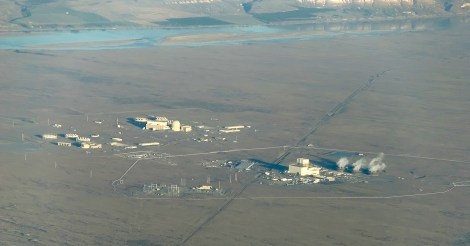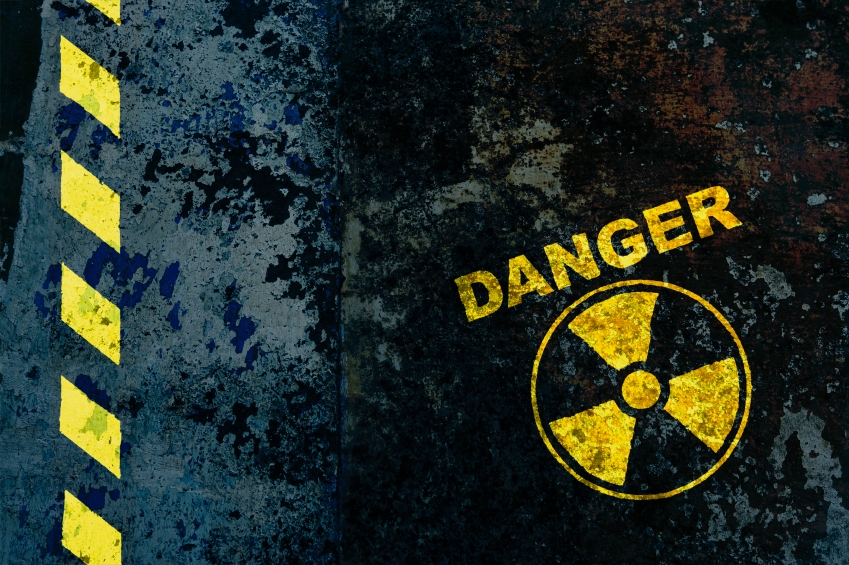A tank storing radioactive waste at America’s most contaminated nuclear site appears to have sprung a leak, leaching yet more cancer-causing isotopes into soil some five miles from the Columbia River in Washington state.

Crash Zone PhotographyThe Hanford site and the Columbia River
The Hanford site produced plutonium that was used to manufacture the bomb that blew up Hiroshima. Now it’s home to a different kind of horror: It’s used to store nuclear waste while a plant is built on site to treat that waste. But the Department of Energy treatment plant project has been plagued by delays, and tanks that were designed to hold the waste temporarily keep falling apart.
An underground tank holding some of the worst radioactive waste at the nation’s most contaminated nuclear site might be leaking into the soil.
The U.S. Energy Department said workers at Washington state’s Hanford Nuclear Reservation detected higher radioactivity levels under tank AY-102 during a routine inspection Thursday.
Spokeswoman Lori Gamache said the department has notified Washington officials and is investigating the leak further. An engineering analysis team will conduct additional sampling and video inspection to determine the source of the contamination, she said.
State and federal officials have long said leaking tanks at Hanford do not pose an immediate threat to the environment or public health. The largest waterway in the Pacific Northwest — the Columbia River — is still at least 5 miles away and the closest communities are several miles downstream.
However, if this dangerous waste escapes the tank into the soil, it raises concerns about it traveling to the groundwater and someday potentially reaching the river.
The AP reports that water samples taken beneath the leaking tank “had an 800,000-count of radioactivity and a high dose rate, which means that workers must reduce their time in the area.”
If the leak is confirmed, it is certainly not the first time that the Hanford site has been home to such an accident. From a February editorial in the Tacoma News Tribune:
Hanford hosts 56 million gallons of hot reactor byproducts in 177 steel-walled underground tanks, some dating to the heyday of Betty Grable. Collectively, they’ve leaked an estimated 1 million gallons of waste into the desert soil, creating radioactive plumes that are gradually headed for the Columbia River.
The Department of Energy put a stop to the big leaks years ago by pumping out liquids from the tanks, leaving crusty, gooey, toxic sludges inside. Water has been penetrating one of these supposedly “stabilized” tanks. The lyrically named T-111 has reportedly resumed leaking at a rate of 150 to 300 gallons a year.
This is a reminder that the nation’s largest concentration of nuclear waste is stored under insanely makeshift conditions. The oldest tanks, including T-111, were engineered to last 20 years. They were built in 1943 and 1944.
Even Hanford’s newer, double-walled tanks – built between the late 1960s and early 1980s – are slowly rotting in the ground. One sprang a leak last fall.
News of the latest suspected leak has state officials gravely concerned, yet again. From a statement by Gov. Jay Inslee:
“This is most disturbing news for Washington. It is not clear yet whether that contamination is coming directly from the outer shell of the AY-102 but it must be treated with the utmost seriousness. The discovery was made during a routine pumping outside the tank when pumps are also surveyed for radioactivity. …
“Even before learning of this new development, I told [Energy Secretary Ernest Moniz] I continue to have serious concerns regarding the pace of addressing the leaking tanks. We will be insisting on an acceleration of remediation of all the tanks, not just AY-102. [The U.S. Energy Department] has a legal obligation to clean up Hanford and remove or treat that waste, and we ensure that legal obligation is fulfilled.”
But it’s not clear how the government could treat the waste anytime soon. From TV station KING5:
The [treatment] plant has been delayed for years by continued problems and is not expected to meet a 2019 deadline to be up and running.
So the tank designed to hold the waste until then is now possibly leaking, no longer dependable, and there is no plan we know of for quickly pumping it out to another double walled tank.
That leaves the DOE and its contractors with fewer places to store 56 million gallons of waste and no plant built yet to treat it.
The AP reports that Energy Secretary Moniz toured the facility on Wednesday and promised Washington a new plan this summer for tackling difficulties with the waste treatment project. Don’t hold your breath (unless your visiting the site).




